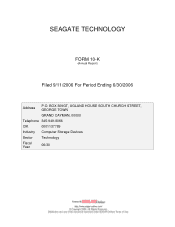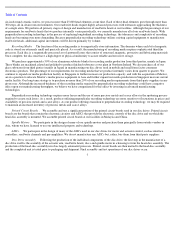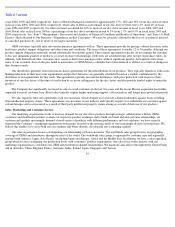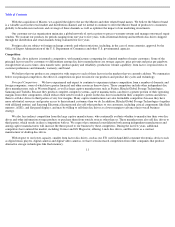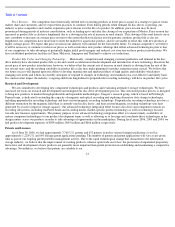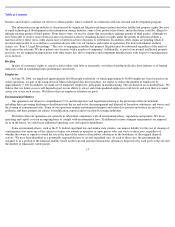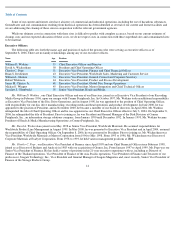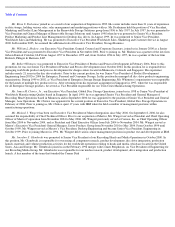Seagate 2005 Annual Report Download - page 7
Download and view the complete annual report
Please find page 7 of the 2005 Seagate annual report below. You can navigate through the pages in the report by either clicking on the pages listed below, or by using the keyword search tool below to find specific information within the annual report.
Table of Contents
Success in Our Industry Depends on Technology and Manufacturing Leadership
The design and manufacturing of disc drives depends on highly advanced technology and manufacturing techniques, especially in the
areas of read/write heads and recording media. Disc drive manufacturers are distinguished by their level of integration, which is the degree to
which they control the technology used in their products, and by whether they are captive, producing disc drives for their own computer
systems, or independent, producing disc drives as a stand-alone product. Integrated manufacturers are companies that design and produce the
critical technologies, including read/write heads and recording media, used in their disc drives. An integrated approach enables them to lower
manufacturing costs and to improve the functionality of components so that they work together efficiently. In contrast, manufacturers that are
not integrated purchase most of their components from third-party suppliers, upon whom they depend for key elements of their technological
innovation and differentiation. This can limit their ability to coordinate technology roadmaps and optimize the component design process for
manufacturing efficiency and product reliability while making them reliant on the technology investment decisions of their suppliers.
Independent manufacturers can enjoy a competitive advantage over captive manufacturers in working with OEMs because they do not compete
with OEMs for computer system sales.
Due to the significant challenges posed by the need to continually innovate and improve manufacturing efficiency, the disc drive industry
has undergone significant consolidation as manufacturers and merchant component suppliers merged with other companies or exited the
industry. Consolidation is likely to continue in our industry as the technological challenges and the associated levels of required investment
grow, increasing the competitive necessity of large-scale operations. We believe the competitive dynamics of the disc drive industry favor
integrated, independent manufacturers with the scale to make substantial technology investments and apply them across a broad product
portfolio and set of customers.
Overview of Disc Drive Technology
All disc drives incorporate the same basic technology although individual products vary. One or more discs are attached to a spindle
assembly powered by a spindle motor that rotates the discs at a high constant speed around a hub. The discs, or recording media, are the
components on which data is stored and from which it is retrieved. Each disc typically consists of a substrate of finely machined aluminum or
glass with a layer of a thin-
film magnetic material. Read/write heads, mounted on an arm assembly similar in concept to that of a record player,
fly extremely close to each disc surface and record data on and retrieve it from concentric tracks in the magnetic layers of the rotating discs.
The read/write heads are mounted vertically on an E-shaped assembly. The E-
block and the recording media are mounted inside a metal casing,
called the base casing.
Upon instructions from the drive’s electronic circuitry, a head positioning mechanism, or actuator, guides the heads to the selected track
of a disc where the data is recorded or retrieved. Application specific integrated circuits, or ASICs, and ancillary electronic control chips are
collectively mounted on printed circuit boards. ASICs move data to and from the read/write head and the internal controller, or interface, which
communicates with the host computer. Disc drive manufacturers typically use one or more of several industry standard interfaces such as
advanced technology architecture, or ATA, Serial ATA, or SATA, which provides higher data transfer rates than the previous ATA standard,
small computer system interface, or SCSI, serial attached SCSI, or SAS, and Fibre Channel.
Disc drive performance is commonly assessed by six key characteristics:
•
storage capacity, commonly expressed in gigabytes (GB) or terabytes, which is the amount of data that can be stored on the disc;
5
•
spindle rotation speed, commonly expressed in revolutions per minute (RPM), which has an effect on speed of access to data;

